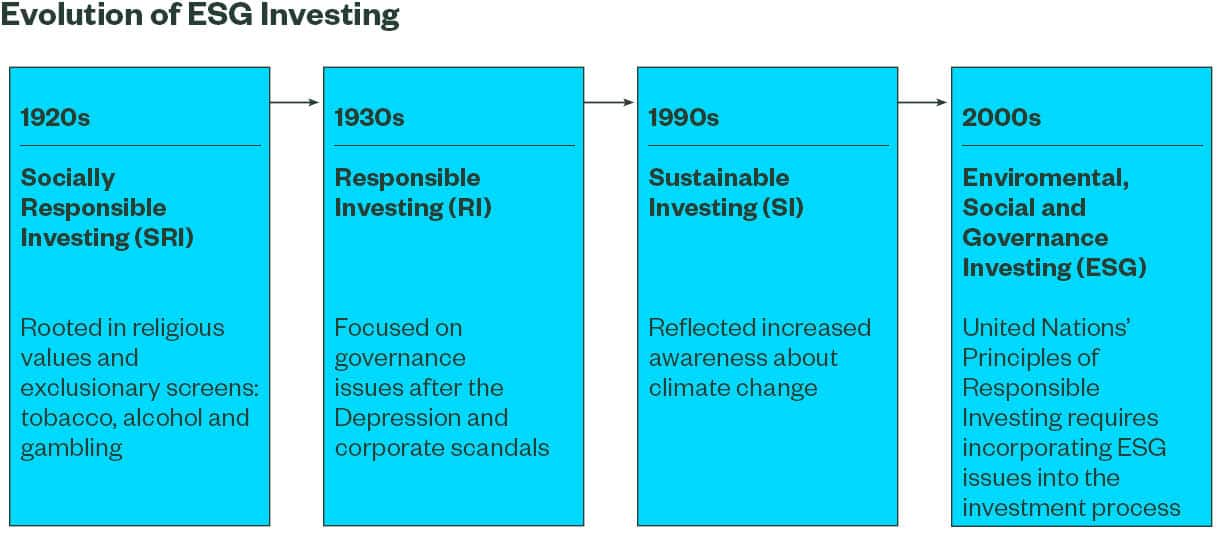By Brie Williams, Head of Practice Management, State Street
Adoption of ESG investing and asset growth has accelerated. You can help clients pursue their goals by effectively integrating ESG principles into portfolios.
Environmental social and governance (ESG) investing tends to land in the spotlight during extreme events like the global pandemic. However, the trend line is unmistakable: ESG investing has been growing for a while. Between 2017 and 2019, ESG investing grew by more than a third, to $30+ trillion, over a quarter of the world’s professionally managed assets.1 Some estimates say it could reach $50 trillion over the next two decades.2
But exactly what is ESG investing? Some think it is all about investing for impact. Others think it is about imposing a certain set of values on companies.

ESG is about informing better decision-making by adding the assessment of material, environmental, social and governance issues to the investment process. It enriches traditional research like analyzing financial statements, industry trends and company growth strategies.
What began as a vehicle for expressing one’s values has evolved into a means of adding value to a portfolio. As State Street Global Advisors President and CEO Cyrus Taraporevala observes, “Addressing material ESG issues is good business practice and essential to a company’s long-term financial performance—a matter of value, not values.”
Incorporate new perspectives on value and performance
Recent research highlighting long-term risk-adjusted returns and lower downside has challenged the notion that ESG investing could mean sacrificing returns.3 Additionally, State Street Global Advisors’ own research finds that 69% of ESG adopters say that pursuing an ESG strategy has helped with managing volatility. Seventy-five percent expect the same returns from those investments as they do from others.4
Yet, while the potential benefits of ESG investing are becoming more clear, sometimes the path for clients to take isn’t as obvious. The increasing number of ESG options reflects the diversity of investor objectives, including:
- Managing risks
- Aligning investments with values
- Pursuing sustainable performance
Some of these objectives span different ESG strategies to varying degrees. And they are not mutually exclusive—multiple ESG strategies can be combined in a single investment vehicle to achieve the investor’s specific goals. Whatever the client’s aim, financial advisors will need to optimize ESG investment opportunities across a range of asset classes and the risk spectrum.
Integrate ESG principles effectively
Effective integration of ESG principles into a portfolio begins with a client-focused process, not a product-focused process. Using a client-centric approach requires advisors to identify suitable ESG strategies, offer beneficial education, and track clients’ progress toward longer-term objectives. Our three-step framework can help advisors focus client conversations on key considerations:
1. Review all the angles to identify a clear entry point
- Determine if and how integrating ESG investing fits into the client’s long-term plan.
- Educate as part of the discovery process. Clarify the motivation to inform the journey, narrow the focus and shape priorities.
- Target opportunities to identify resources and ESG investment strategy selection.
Keep in mind: What are the client’s investment objectives? What are the client’s ESG priorities? Where are the market opportunities?
2. Keep risk in perspective
- Select the degree of ESG integration.
- Assess the broader asset allocation to keep the investment plan properly balanced. Avoid introducing sector or style biases.
- Review personal values and risk framework with clients to help them understand ESG investing considerations.
Keep in mind: What are the client’s desired outcome priorities? Is ESG all or just part of a client’s portfolio allocation?
3. Take the long view
- Understand the client’s perspective and align expectations on non-financial outcomes and reporting.
- Define success as part of the investment plan.
- Modify ongoing reporting to address client’s priorities. Adapt portfolio as motivations shift.
Keep in mind: What is the client’s time horizon and intended impact? How is the client defining and measuring success?
Looking ahead
ESG enables clients to invest with greater precision—to apply a broader lens to more deeply analyze investments. Whether they want to match investments with their mission or pursue enhancing long-term performance, ESG can help meet their goals. It’s a new way of valuing the future.
For more on advising clients about ESG investing, you can read “Aim Higher: Helping Investors Move from Ambition to Action with ESG Investment Approaches.”
Originally published by State Street Global Advisors, 8/12/20
1 State Street Global Advisors. “Into the Mainstream: ESG at the Tipping Point.” November 2019.
2 www.cnbc.com. “Your complete guide to investing with a conscience, a $30 trillion market just getting started.” December 14, 2019.
3 Gunnar Friede, Timo Busch & Alexander Bassen, “ESG and financial performance: aggregated evidence from more than 2000 empirical studies”, Journal of Sustainable Finance & Investment, Volume 5, Issue 4, p. 210-233, 2015. Benice Napach, “ESG-Focused Funds Are Outperforming During Pandemic, Think Advisor, May 21, 2020. Morningstar, “How Did ESG Indexes Fare During the First Quarter Sell-off?” April 8, 2020.
4 State Street Global Advisors. “Performing for the Future.” 2017 Survey.
The returns on a portfolio of securities which exclude companies that do not meet the portfolio's specified ESG criteria may trail the returns on a portfolio of securities which include such companies. A portfolio's ESG criteria may result in the portfolio investing in industry sectors or securities which underperform the market as a whole.
Investing involves risk including the risk of loss of principal.
The whole or any part of this work may not be reproduced, copied or transmitted or any of its contents disclosed to third parties without State Street Global Advisors’ express written consent.
Read more on ETFtrends.com.The views and opinions expressed herein are the views and opinions of the author and do not necessarily reflect those of Nasdaq, Inc.



